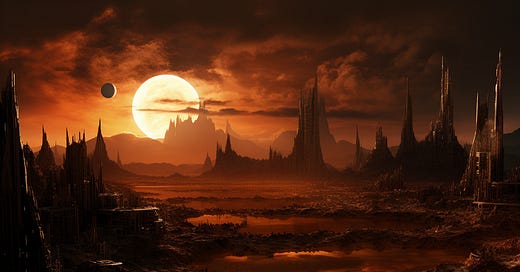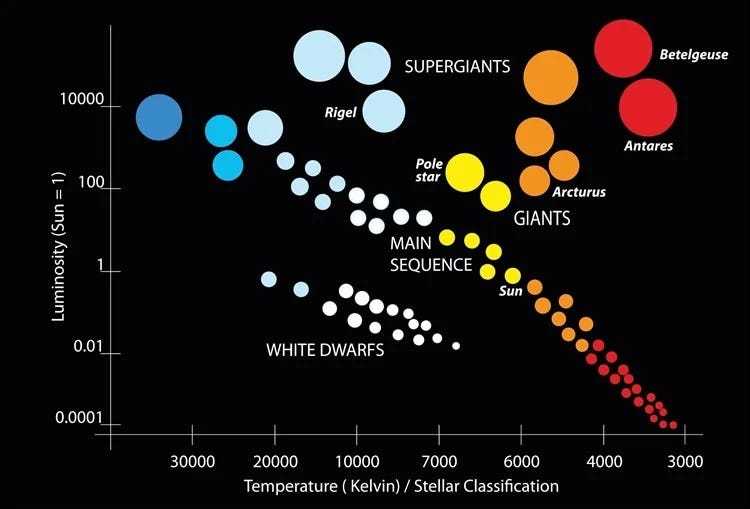Ideas are everywhere if you’re open to them, but I get mine mostly from books. Science books, in particular, because they’re such fertile ground for science-fiction ideas. For today’s essay, I thought I’d share the raft of ideas I took from just one book I read a few years ago: Aliens and Alien Societies.
Written by Stanley Schmidt and published in 1996, Aliens and Alien Societies is a reference book that covers a heap of physics, chemistry, and biology for writers who want to create scientifically plausible aliens and alien societies. It’s dense, but also a treasure trove of scifi ideas. Let’s dive into some of them.
The Stars and Their Planets
Many of the stars we see in the night sky aren’t single stars. They’re two or more stars orbiting their common center of mass. As you begin creating the world of your scifi story, ask yourself: Does my planetary system have one or more stars? If more, how does that affect life on the planets and moons around them?
If you opt for the more traditional single-star planetary system, you still have to decide where your star sits on the Hertzsprung-Russell diagram at the time of your story: f you look at the diagram below, your star almost certainly won’t sit top left, because those stars don’t exist long enough to develop advanced life. It probably won’t be top right either, because those stars are too feeble. But somewhere else along the Main Sequence will work and should influence what your alien society looks like.
You may think of this as too complicated or too limiting, but multiple story ideas can spring forth if you’re willing to dig into the science a little. For example, a binary star system could have a planet that orbits one star for a while, then switches to the other star. The planet is closer to one star than the other, and when it makes the switch to the more distant star, it will be plunged into an ice age for millions of years. The story begins with an advanced alien civilization right before their planet switches stars. Are they prepared?
That sounds like a killer premise to me, and it only took me a few minutes to come up with. You see what I mean? Knowing a little about science yields an almost infinite pool of ideas. Let’s continue.
Once you’ve decided on your star(s), you should consider the axial tilt of your planet, or the angle at which your planet rotates its star. Earth has an axial tilt of 23.5° and it’s the reason we have seasons. The bigger the tilt, the more extreme a planet’s seasons.
Next up is day length. How quickly does your planet rotate around its own axis? Jupiter zips around itself every ten hours, the fastest of all the planets in our solar system. Then there’s Venus, which takes 243 days to complete one spin around itself. On Venus, a day is longer than a year. Consider how such a day would influence the alien society of your story.
Alien Life
Aliens and Alien Societies assumes that advanced lifeforms originate from simpler lifeforms. Once again, that’s an assumption you can play with. Is it possible for life to evolve from advanced to simple? Can lifeless wads of biological material assemble into a giant structure, after which it zaps into life? What if that large lifeform then splits and splits and splits into smaller, nimbler lifeforms? The assumption reversed.
Life as we know it relies heavily on carbon, the chemical element that is exceptionally capable of forming the kind of complex molecules life needs. Are there other elements that life could form from? Silicon is one candidate, because it’s abundant and in many ways similar to carbon. What would silicon life look like?
Similarly, all life as we know it relies on DNA to store and transmit information. But is DNA the only way to do so? Could alien life use another polymer? Or maybe it uses DNA, but it’s a quadruple helix instead of a double helix. This isn’t a fantastical thought: quadruple-stranded DNA has been found in human cells.
What about the solvent in which biological reactions take place? Water is an excellent solvent because it can dissolve more substances than anything else, but that doesn’t mean water is the only option. Hydrogen fluoride, ammonia, and methane are only a few of the alternatives.
And let’s not assume that our aliens are animal- or human-like. Maybe they’re highly intelligent, mobile plants. It’s not entirely implausible if you give them enough energy and an efficient way to convert that energy. Maybe they rely on something other than chlorophyll for their photosynthesis (in which case they wouldn’t be green)?
You have a lot of freedom with the biology of your aliens. If anything, it’ll be hard to create something that doesn’t already exist on Earth. Multiple brains? Just like an octopus. An external exoskeleton? Crabs and lobsters. Metamorphosis? Butterflies and moths. Learn about life on Earth and you’ll never be short of ideas about alien biology.
Alien Societies
Are your aliens the prime species of your planet? What if they’re not? What if they live on a planet where they’re constantly hunted by a less intelligent predator? Now there’s an interesting idea to play with. What if there are two similar species on one planet that are equally intelligent? Like the Neanderthals and the Humans. Another idea.
How do your aliens exchange information? Maybe they don’t use language as we know it. Maybe they dance (like bees do). Maybe they use telepathy (it’s possible). Maybe they’re all dead biologically but still alive digitally, and the only way to communicate with them is through some technological interface. Ideas, ideas, ideas.
As a final point, if your alien civilization consists of large cities, play around with the infrastructure of those cities. There will have to be some kind of food production, waste disposal, resource extraction. This makes it easier to come up with interesting jobs for your alien characters. An alien salt miner, factory worker, scrapyard employee. Endless possibilities.
Always Stay Curious
This was only a snippet of what I took from Aliens and Alien Societies. And that’s just one book. The more books you read, the more you’ll be able to play with facts to create something unique. You’ll also learn about a field’s assumptions and the limits of our knowledge there. Those gray areas are great places for ideas too.
None of these ideas will give you a fully-fledged story, but that’s not the point of an idea. An idea is a starting point, a direction to move in, an avenue to research. As you do, you’ll almost automatically flesh out your idea until you have something that feels like it could be a short story or a novel or a trilogy of books. And you’ll be learning about the world in the process.
Where do you get your ideas from? Let me know with an email reply or a comment.




